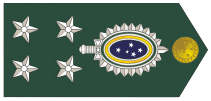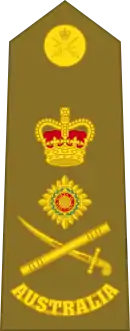Four-star rank
A four-star rank is the rank of any four-star officer described by the NATO OF-9 code. Four-star officers are often the most senior commanders in the armed services, having ranks such as (full) admiral, (full) general, or air chief marshal. This designation is also used by some armed forces that are not North Atlantic Treaty Organisation (NATO) members.

Australia
In the Australian Defence Force, the following ranks of commissioned officers are awarded four-star ranks:
- Admiral (Royal Australian Navy four-star rank)
- General (Australian Army four-star rank)
- Air chief marshal (Royal Australian Air Force four-star rank)
The four-star rank is reserved in Australia for the Chief of the Defence Force, the highest position in peacetime.
In times of major conflict, the highest ranks are the five-star ranks: admiral of the fleet, field marshal, and marshal of the Royal Australian Air Force.
Bangladesh
- General (Bangladesh Army four-star rank)
- Air chief marshal (Bangladesh Air Force four-star rank)
- Admiral (Bangladesh Navy four-star rank)
Brazil

- General de exército (Brazilian Army four-star rank)
- Almirante de esquadra (Brazilian Navy four-star rank)
- Tenente brigadeiro (Brazilian Air Force four-star rank)
The four-star rank is reserved in Brazil for the highest post in the military career. The officers in this position take part of the high command of their corporations. The commanders of army, navy and air force are also four-star generals, but they have precedence to all the others military in this rank.
Cambodia
- Neay odom senei (general) (Royal Cambodian Army, four-star rank)
- Neay odom neavi (admiral) (Royal Cambodian Navy, four-star rank)
- Neay odom senei (general) (Royal Cambodian Air Force, four-star rank)
Canada
- Admiral/amiral (Canadian Forces officers authorized to wear naval uniform four-star-equivalent rank)
- General/général (Canadian Forces officers authorized to wear army and air force uniform four-star-equivalent rank)
General/admiral is the highest rank within the Canadian Armed Forces as defined within the National Defence Act.[1] Usually, only one officer, the Chief of the Defence Staff, carries the rank of full admiral or general at any one time. However, the crown may authorize additional officers at that rank for special cases such as for Canadian officers in the position of Chairman of the NATO Military Committee, who are usually former Chiefs of the Defence Staff seconded to NATO for that duty.
The Queen of Canada, Elizabeth II, is Commander-in-Chief of the Canadian Armed Forces.[2] However, in line with the Letters Patent, 1947, the duties and title of commander-in-chief are normally exercised by the Governor General of Canada.[3] The Minister of National Defence, since not a member of the Canadian forces nor within the military chain of command, has no rank. Prince Philip holds the four-star rank of admiral in the Royal Canadian Navy in an honorary capacity as of 2011.
Before unification in 1968, the rank of air chief marshal (maréchal en chef de l'air) was the four-star equivalent for the Royal Canadian Air Force.
Germany
The equivalent modern German four-star ranks (OF-9) of the Bundeswehr are as follows:
Not to be confused with Generaloberst and Generaladmiral, the Wehrmacht and Kriegsmarine equivalent until 1945, or Armeegeneral and Flottenadmiral, the National People's Army and Volksmarine (East Germany) equivalent until 1990.
India
- General Indian Army four-star rank
- Admiral Indian Navy four-star rank
- Air chief marshal Indian Air Force four-star rank
These four star rank officers from respective services are appointed as Chiefs of the Army (COAS), Navy (CNS), Air Force (CAS). A four star rank officer from either service is appointed to the post of Chief of Defence Staff.
Indonesia
- Jenderal (general) – Indonesian Army, Indonesian Marine Corps and Indonesian National Police four-star rank
- Laksamana (admiral) – Indonesian Navy four-star rank
- Marsekal (air chief marshal) – Indonesian Air Force four-star rank
Italy
- Generale di Corpo d'Armata con Incarichi Speciali (general with special duties) – Chief-of-Staff of the Italian Army
- Ammiraglio di Squadra con Incarichi Speciali (admiral with special duties) – Chief-of-Staff of the Italian Navy
- Generale di Squadra Aerea con Incarichi Speciali (general with special duties) – Chief-of-Staff of the Italian Air Force
- Generale di Corpo d'Armata Comandante Generale (commander general) – Commander of the Carabinieri
Japan
- General – 幕僚長たる陸将 (Bakuryōchō-taru-rikushō, (Rikushō serving as Chief of Staff)) – Japan Ground Self-Defense Force four-star rank
- Admiral – 幕僚長たる海将 (Bakuryōchō-taru-kaishō, (Kaishō serving as Chief of Staff)) – Japan Maritime Self-Defense Force four-star rank
- General – 幕僚長たる空将 (Bakuryocho-taru-kūshō, (Kūshō serving as Chief of Staff)) – Japan Air Self-Defense Force four-star rank
The rank designations of general and admiral are merely the status and treatment of the position of chief of staff, with lieutenant general and vice admiral being the highest ranks.
Pakistan
- Chairman Joint Chiefs of Staff Committee (Four-star rank)
- General (Pakistan Army four-star rank)
- Air chief marshal (Pakistan Air Force four-star rank)
- Admiral (Pakistan Navy four-star rank)
Sri Lanka

- In Sri Lanka Armed Forces only the Chief of the Defence Staff can hold a full general or full admiral or air chief marshal rank.
Philippines
- Admiral (Philippine Navy four-star rank)
- General (Philippine Army four-star rank)
- General (Philippine Air Force four-star rank)
- Admiral (Philippine Coast Guard four-star rank)
- Commissioner (Bureau of Immigration four-star rank)
- Police General (Philippine National Police four-star rank)
United Kingdom
- Admiral (Royal Navy four-star rank)
- General (British Army and Royal Marines four-star rank)[4]
- Air chief marshal (Royal Air Force four-star rank)[5]
See also:
- List of Royal Navy admirals
- List of Royal Marines full generals
- List of British Army full generals
- List of Royal Air Force air chief marshals
United States
- Admiral (United States Navy, Coast Guard, Public Health Service Commissioned Corps and NOAA Corps four-star rank)
- General (United States Army, Marine Corps, Air Force, and Space Force four-star rank)
See also:
- List of active duty United States four-star officers
- List of United States Navy four-star admirals
- List of United States Coast Guard four-star admirals
- List of United States Public Health Service Commissioned Corps four-star admirals
- List of United States Army four-star generals
- List of United States Marine Corps four-star generals
- List of United States Air Force four-star generals
- List of United States Space Force four-star generals
Former USSR and Russia
- General armii (infantry and marines of the Red Army, Russian Army and Air Force four-star rank)
- Glavnii marshal and marshal (four-star equivalents of the Soviet Air Force, and of the other branches of the Red Army)
- Admiral flota (four star equivalent of the Soviet and the Russian navies)
While the general armii wore shoulder insignia with four small stars, the marshal and admiral flota wore one single large star on their shoulder boards, and the glavnii marshal the same large star with a laurel wreath, very similar to the modern army general insignia of the Russian Army.
Upon their formation, the Russian armed forces discontinued the ranks of marshal and glavnii marshal.
Notes
- This rank insignia is not worn by all NATO officers.
References
- Canada – Department of Justice "Laws of Canada: National Defence Act, Schedule I"
- Lagassé, Philippe (December 2013). "The Crown's Powers of Command-in Chief: Interpreting Section 15 of Canada's Constitution Act, 1867" (PDF). Review of Constitutional Studies. 18 (2): 189–220.
- The Governor General, Commander-in-Chief ""
- "Archived copy". Archived from the original on 2012-08-21. Retrieved 2012-08-19.CS1 maint: archived copy as title (link)
- RAF Glossary Archived 2008-04-13 at the Wayback Machine, "Air of Authority – A History of RAF Organisation", rafweb.org









